Human Flower Project
Kurt Bluemel: All the Glory of Grass
Allen Bush profiles one of the great living horticulturists, who just turned 75. Kurt Bluemel was one of a group of European nurseryman who brought their expertise to the U.S. after World War II and changed the American landscape.
By Allen Bush
Kurt Bluemel reigns in the kingdom of ornamental grasses. Wolfgang Oehme and nurseryman and designer John Greenlee use grasses as significant features of their bold designs; and Rick Darke wrote The Encyclopedia of Grasses—a masterful book. But there can be only one undisputed King. Renowned nurseryman, landscape designer, past president of the American Horticultural Society, Bluemel has earned his title: Der Gras König.
I met him in Asheville, North Carolina, in 1984 at the 50th anniversary celebration of the North American Rock Garden Society. Bluemel had driven down from Fallston, Maryland – on up the Blue Ridge Parkway—with his beautiful wife, Hannah, in a green Porsche. (Handsome German cars are rare rides for nurserymen who usually get around in beat-up trucks.) He was already something of a legend, and I was a young, struggling nurseryman with a farm outside Asheville. I was impressed.
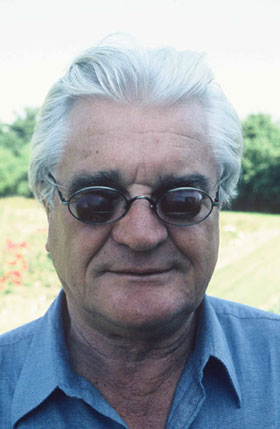 Kurt Bluemel with chestnut eyes, Czech Republic, 1999
Kurt Bluemel with chestnut eyes, Czech Republic, 1999
Photo: Allen Bush
I still am. Across more than two decades, I have gone looking for plants every few years in nurseries, gardens and the wild with Bluemel and a small group of friends. We have driven dust-choked roads in Argentina looking for hardy Hippeastrum bulbs and sped along the German Autobahn to pay homage to nurserywoman Countess Helene von Stein Zeppelin of Laufen, in the Black Forest. (Her uncle was Count Zeppelin of dirigible fame). We have visited Brno, the Czech Republic town where Gregor Mendel became obsessed with peas, and hiked dazzling alpine meadows near Carbondale, Colorado. Plants are our love and living.
This gang of eight, made-up of nurserymen, seedsmen, a horticulture professor and a landscape architect, first traveled in 1987 at the invitation of Bluemel and German seedsman Klaus Jelitto. Late one evening, during the ten-day tour of German perennial nurseries and gardens, in the rathskellar of the Heide-Kröpke Hotel near Celle in northern Germany, we were anointed by bar patrons with the peculiar, vile-tasting ginger based Ratzeputz liqueur.
Only the next morning did the colloquial term for Ratzeputz get roughly translated, as “radiator cleaner”. We became the Ratzeputz Gang.
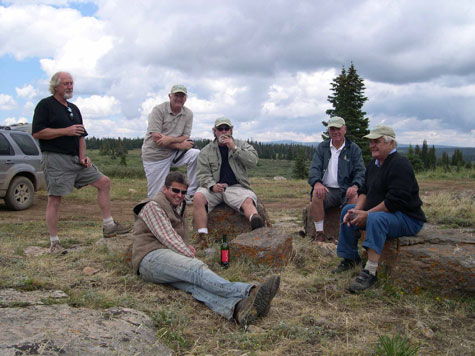
The Ratzeputz gang in Colorado 2007: Front (l-r) George Uebelhart, Kurt Bluemel; back (l-r) Kirk Alexander, Steve Still, Dave Schultz, Pierre Bennerup (not pictured, photographer Allen Bush)
Bluemel, seventy-five, was born in Liberec. in what is now the Czech Republic. He has leathery hands, fingers thick as ginseng roots, and walks with the sturdy bearing of a shipboard sailor. His full head of silver hair would do Cesar Romero proud.
Plants and gardening weren’t a part of his early childhood. He was a poor, street kid who ran with another thug named Fritz Hübner. “He was one of our gang members, a real tough kid, so when he showed up one day with a box of blue pansies we stoned him – but not to death,” Bluemel confesses, with the we-got-him-good wink of a boy. Turns out, Hübner, just 14, had finished elementary school and started an apprenticeship. He chose gardening. “We called him ‘The Daisy Boy.’”
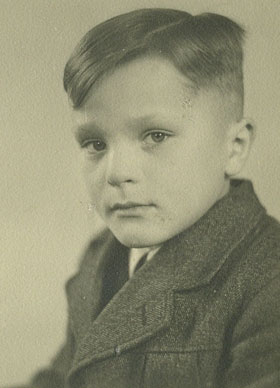 Kurt Bluemel, age 7, 1940
Kurt Bluemel, age 7, 1940
Bluemel the street kid was a smart kid. He applied and was accepted to the prestigious National Politische Erziehungs Anstalt (National Political Educational Instititute) in the village of Ploschkoviz. (Hardy Krüger, who appeared in the1965 movie Flight of the Phoenix with Jimmy Stewart, was a graduate.) “My brother, Franz, two years older, was a student and I wanted to be there,” Bluemel said. He and his brother were the only students chosen from Liberec, a town of 100,000. Similar schools existed in every German state and were training grounds for military officers, politicians and scientists. The NPEA gave Bluemel discipline and an education he soaked-up, but his studies were cut short three years later.
The Czechoslovakian Revolutionary Guards sought reprisals against German-speaking people when War II ended in 1945, and the Bluemels fled the Sudentland (now the northern Czech Republic) for Germany the following February. Kurt was 13. With the Russians in hot pursuit this time, the family boarded a packed freight train, not sure where they were going, and ended-up in Burtenbach, a small Bavarian agricultural town. Among struggling post-war villagers, the Bluemels were refugees.
His formal education over, Kurt was asked to help provide simple necessities for the family; he rode his bike into the Mindel Valley countryside and found work on a farm. Work he would.
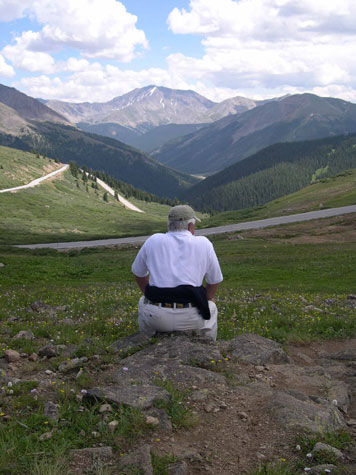 Kurt Bluemel overlooking Independence Pass, Colorado, 2007
Kurt Bluemel overlooking Independence Pass, Colorado, 2007
Photo: Allen Bush
Bluemel still remembers herding cows for his farmer-employer late in the fall, surrounded by millions of autumn flowering Colchicums (Colchicum autumnale) and seeing the Alps sixty miles south. The extraordinary scene fascinated him. The mountains seemed a stone’s throw away to an impressionable teenager, though for someone traveling on foot and a bike, they were a world away.
Jobs were scarce, but nursery work – growing vegetable starter plants and cemetery flowers for the war dead – was available. The teenager wasn’t taken with plants but got a nudge from his step-father, Bruno Lammo, whom Bluemel fondly remembers: “He was a nurseryman, playboy,” and two-time member of the Czechoslovakian soccer team.
In 1950 Bluemel was earning $8.00 a month working for his step-father, when he read a want ad in the German horticultural trade magazine Südeutscher Erwerbsgärtner (published by Klaus Jelitto’s father). The Swiss nursery Märkle Gemüse Bau in Zurich, specializing in year round vegetable production, was hiring. Pay was an extraordinary $45.00 a month and included room and board. “The water was free,” Bluemel joked. He left for Switzerland in June, 1951. The Alps were within reach.
Days began at 4:30 in the morning and ended at 10:00 at night, six days a week, with a short work day on Sunday, ending at 2:00. The food was plentiful and tasty. Italian cooks prepared meals that he still remembers as “unbelievable.” Daily servings of fresh lettuce, spinach, mustard greens, endive, beets, carrots and cucumbers supplemented by dark Swiss bread – plus polenta and bacon three times a week – were a huge improvement over post-war Bavaria’s boiled cabbage and potatoes.
In March 1953, Bluemel took a pivotal job—with Arnold Vogt Gartenbau, specializing in perennials and rock garden plants. He stayed on for six years, attaining a position as lead foreman and getting his first exposure to ornamental grasses. Vogt traded plants with Walter Ingwersen in East Sussex, England, and Jack Drake in Aviemore, Scotland, Europe’s recognized nursery leaders of rock garden and alpine plants. And the company’s flourishing landscape business gave Bluemel his first experience with garden design and construction.
Bluemel married his first wife, Jaqueline Meystre, in 1953, and their daughter, Catherine, was born in 1954. He needed to supplement his modest income, and Vogt introduced him to Lavoslav Ružička, a 1939 Chemistry Nobel Laureate. After Ružička had acquired a notable collection of baroque art—including Rembrandt, Hals and Rubens—he turned his attention to a two-acre hillside garden overlooking Lake Zurich. Bluemel was hired to work Saturdays.
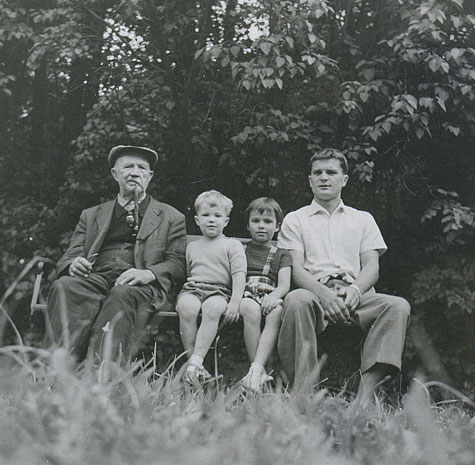
Last day in Europe, 1960: (l-r) Grandfather Franz Bluemel, son Andre, daughter Catherine, and Kurt
Photo: Courtesy Kurt Bluemel
Ružička had formal borders, a parterre, and a long pergola sloping down the hill. But it was the substantial, one-acre sunken rock garden that astounded the young professional. Carl Frikart had built the rock garden in the 1930s out of imported German red sandstone and eight-foot pieces of porous limestone tufa. This was where Bluemel encountered his first rock garden plantings, falling in love with alpine lewisias, Himalayan blue poppies and Asian gentians. Ružička spotted a hard-working gardening talent – someone with good design sense – and encouraged the young man’s artistic interests. And Bluemel gratefully remembers Ružička: “I felt very much at home.”
Richard Simon of Bluemount Nurseries, in Monkton, Maryland, interned at Vogt’s Zurich nursery in 1957. Meeting Bluemel, Simon offered him employment propagating plants for the family business back in the States. Bluemel’s son, André, had been born the year before, and after visa delays, the family arrived in America in 1960. It wasn’t the land of opportunity he had imagined. “I wanted to come back home. It was a horticultural and cultural no man’s land,” Bluemel says of the U.S. “If I had had the money, I would have begged for my Swiss job back.”
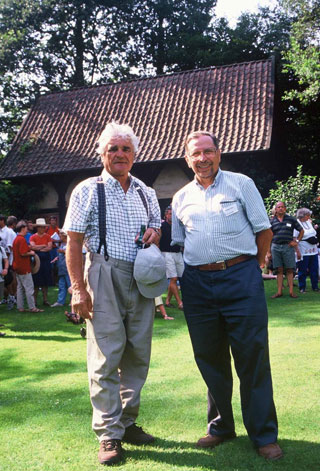 Kurt Bluemel and his friend and former partner Wolfgang Oehme, 2001
Kurt Bluemel and his friend and former partner Wolfgang Oehme, 2001
Photo: Allen Bush
Soon he met Wolfgang Oehme, who had arrived from Germany three years earlier. Oehme was working for a landscape architect and had some private customers on the side. Bluemel was delighted to meet another plantsman. The two began sharing information, collecting seeds of unusual species and importing plants from Switzerland and Germany.
And Bluemel began moonlighting as a grave digger (As proven back in the Mindel Valley farm, Bluemel could work!). Handy, with a spade, he could make as much money in two hours digging graves at the Monkton, Maryland’s St. James Episcopal Church cemetery as he could propagating perennials in a week at Bluemount. There was opportunity after all.
In 1964, after four years at Bluemount, Bluemel went into partnership with Oehme and two of Oehme’s clients, Leo and Pauline Vollmer. Oehme and Bluemel each put-up $10,000 for a 25% share; the Vollmers, silent partners, put in $20,000 and held the remaining 50%. They purchased forty-three acres in Fallston, Maryland. Here, the street thug turned “Daisy Boy” found a home and nursery, and has been there since. (Oehme sold his shares two years later and began a successful landscape design business with Jim Van Sweden. When Leo Vollmer died, Bluemel exercised the buy/sell agreement and became sole owner.)
Bluemel and his wife Hannah share a beautiful modern home on the Fallston farm, renovated with several additions over forty-four years. It sits on a hillside above the nursery. Broad sweeps of perennials and grasses surround their house, anchored by stately trees—some planted in 1964. (Bluemel has occasionally sold some of the specimen trees, fetching individual prices well above his initial nursery investment cost.). A Pennsylvania bluestone patio surrounds the front of the house. Just beyond is a swimming pool, partially hidden by a rock garden. At the bottom of the hill is a half-acre pond backed by a large bower, planted with the climbing Dutchman’s Pipe, Artistolochia macrophylla.
The plantsman has a research and development greenhouse only a hundred yards away. He putters around checking rare new accessions grown from seed exchanges or collection trips abroad. If they catch his fancy, these plants may someday be added to his gardens and – if they prove durable – might make it into his nursery catalog. He counts seven hundred species and cultivars of ornamental grasses and sedges, one thousand five hundred perennials and one hundred bamboos among his inventory (not all are listed in the catalog). Bluemel’s most popular commercial introductions have included the gray-green switch grass, Panicum ‘Heavy Metal’; a mid-sized Joe-Pye weed, Eupatorium ‘Gateway’; and the little blue stem grass, Schizachyrium ‘The Blues.’
Bluemel’s nursery success forged his international reputation but his landscape business made him wealthy. In 1965, he built a six figure garden for Fairchild Hiller, whose family’s firm designed the first fully enclosed airplane cockpit, hydraulic landing gear and the Fokker F-27 turboprop; in 1968-69, he designed and constructed a garden for Howard Head that priced-out at a half-million dollars. Head, the owner of Head Ski Company and Prince Manufacturing, told Bluemel, “I can’t wait for little trees to grow.” So Bluemel didn’t make him wait; he found all the big trees Head wanted.
The nurseryman’s plant palette was bolstered by his artistic sense and practical know how. Walls, rock gardens, swimming pools are within his grasp. He knows what will grow, can design and construct the hardscape, and has an intuition about how much maintenance his clients can handle. They all want a beautiful garden but few fully understand what is required to keep one going. Bluemel convinces them that he can build it, and shows them what would be required to maintain their gardens (usually more than they imagined). Then, the savvy salesman makes the drudge work sound not only essential but appealing. Of course, if they grow weary of maintenance – and they often do—he can organize crews who handle that, too.
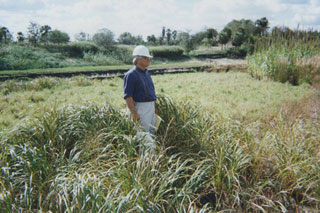 Bluemel at the Disney Animal Kingdom
Bluemel at the Disney Animal Kingdom
Photo: Courtesy Kurt Bluemel
Bill Evans, the legendary Disney Company Director of Landscape Architecture, came to visit Bluemel thirteen years ago. (Evans had grown up in a gardening family that owned a nursery and landscape company, with Greta Garbo, Clark Gable, Elizabeth Taylor and Laurence Olivier as customers. In July 1954, Walt Disney asked Evans and his brother, Jack, if they’d be interested in landscaping the 80-acre Magic Kingdom for an opening the following year.)
Evans contacted Bluemel in 1995 about a 600-acre Animal Kingdom project that Disney planned in Florida. Evans wanted to include a 125-acre savannah planted with ornamental grasses. Bluemel flew to California to see scale models, then traveled to Orlando to visit the site. Bluemel was hired. He considered it an honor to work with Evans, “…a treasure trove of knowledge… an icon.”
By March 1996, The Walt Disney Company had moved a million cubic feet of soil and was ready to plant. The scope of the project was unlike anything Bluemel had done. Bluemel called it “the job of a lifetime.” He and his staff provided and planted most of the ornamental grasses, nearly a million plants, before the Animal Kingdom opened in April 1998. The immense job enabled his company to open a Florida production nursery.
 Janet Draper, one of Bluemel’s many protegees, now chief horticulturist at the Smithsonian’s Ripley Garden, Washington, D.C.
Janet Draper, one of Bluemel’s many protegees, now chief horticulturist at the Smithsonian’s Ripley Garden, Washington, D.C.
Photo: Allen Bush
By any measure, Bluemel is a huge success, yet he’s at an age where he takes considerable pride in the growth of others who have worked for him. Janet Draper is now the chief horticulturist for the Ripley Garden at the Smithsonian in Washington, D.C.; Cassian Schmidt, is Garden Director of Hermanshof, the teaching and research garden in Weinheim, Germany; Dave Schultz, grandson of the founder of Wayside Gardens and past president of the Perennial Plant Association (Bluemel is also a past president), runs Bluemel’s Florida division; Ed Snodgrass, author and Maryland nurseryman, is North America’s leading green roof consultant; and Swiss plantsman, Georg Uebelhart is a co-owner of Germany’s Jelitto Staudensamen GmbH, a perennial seed company with over 3,000 varieties.
Daughter Catherine works at her father’s third farm on the Eastern Shore; her two sons are learning the ropes. Bluemel is a painter of considerable talent and wants to find time for sculpture. But there are breeding ideas that stir his thoughts; color combinations for new garden plantings beg to be tried. How could he retire? Kings don’t do that.
Comments
Thanks, Susan. I love what you do on the Garden Rant!
Impressive plantsman, and profile writing! I have not visited any of the Disney parks, but now am eager to visit Animal Kingdom – to see Bluemel’s savannah of ornamental grasses.
Thanks, Georgia. I hope you get to visit one day.
Allen, thank you, Win


Great article, Allen – thanks! I just wrote about Kurt myself over on GardenRant, in a MUCH shorter, less comprehensive version, I’m afraid. I do have a few photos of his home, garden and nursery.
http://www.gardenrant.com/my_weblog/2008/10/is-kurt-bluemel.html
I’m doing an article about grasses and Kurt for my local paper and thanks to you, my Bluemel research is all done!~